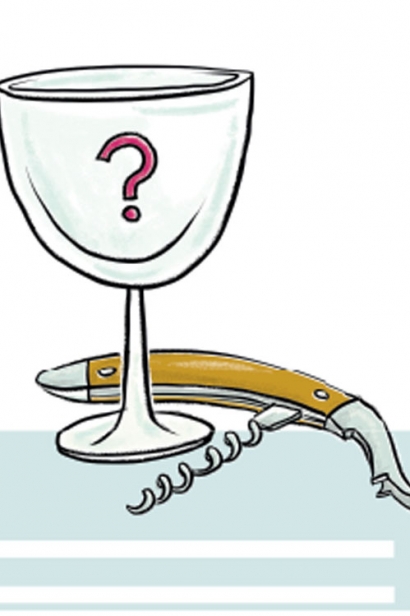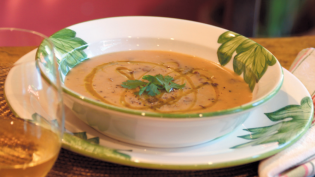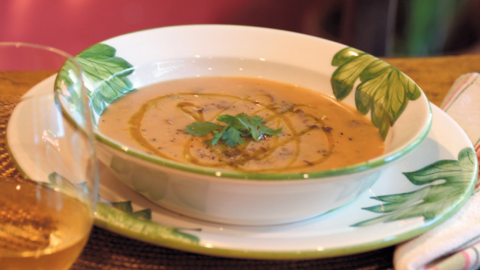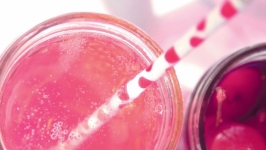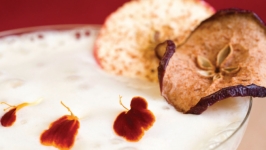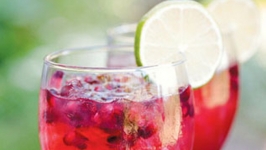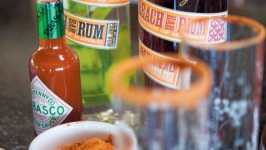The Soup Shall Set You Free: Pairing Wine with Soup
Soups, like salads, seem to trip up the wine world. For centuries, the conventional wisdom has been that soups are difficult to bring to the table with wine. It is worth mentioning that this sort of nonsense also left the wine elite of yesteryear cowering at the sight of eggs, artichokes and asparagus.
We can only surmise that the authors of these long held rules and regulations of fine dining found the soups of their day off-putting with the wines of their day, or at least thought it sounded smart. I’ll grant that consommé and other clear broth-based soups aren’t terribly exciting with most beverage partners, because of their textural similarity, but there is a big world of soup out there, and an equally big world of wine, so surely we can find a few combinations that don’t repel each other.
Since a soup might be crafted to have any aroma, flavor, color or temperature we find in so-called “wine-friendly” solid foods, we are left with texture as the only possible deal-breaker. If texture, the liquidity of soup, is the root of this problem, then texture is probably the starting point for a solution.
Building texture in soup is easy. Imagine a bowl of the most elemental vegetable soup: chunks of vegetable in broth. A “brothy” soup, even if it is well seasoned, is relatively light eating. Now, imagine the texture of the exact same vegetable soup recipe after a short visit with your blender. Puréed, with no other adjustments, it would become heavier, literally coating the palate. Voila! You have increased the body of your soup in seconds. Now, stir in a bit of heavy cream, and sprinkle toasted croutons over the surface, and you really get things going. With a bit of body, and a few simple garnishes, soup seems less like a wine challenge and more like an astounding opportunity to tailor food to wine.
In a land of do-as-I-say recipes, soup is pure freedom. For some strange reason, folks who won’t scramble an egg without a dog-eared cookbook, iPad or Kindle in front of them make and garnish soup with an extra drizzle of olive oil, a gratuitous grating of cheese, a secret dash of hot sauce, unabashed cracker crumbling or the wanton dip of an unauthorized sandwich, and do so without the slightest apprehension. The essential nature of every bite is changed instantaneously, and fundamentally.
Even people who never make soup themselves seem to have no trouble deciding exactly how to eat their soup, and go about making it happen with no visible anxiety. My father, who cooks little and cares little to cook, is very serious about his soup. I remember watching in fascination, 40 years ago, as he deftly processed oyster crackers to a coarse powder over a bowl of avgolemono soup at a Greek diner, fingers against palm, in a slow, clockwise motion. This was not some authentic Greek tradition. This was dad’s soup mojo. He approached the soup bowl with confidence, originality and daring.
Soup is an Everyman thing. Maybe that’s why the wine elite have dismissed it. I say embrace the soup, and the soup shall set you free.
Thus, we should capitalize on the license we have been granted to manipulate our soup, especially when bringing a bottle of wine to the table. Just ask yourself a question or two: What has the wine got? What has the soup got? What loves both? OK, now stir part or all of that list into the soup, sprinkle it on top of the soup or dip it into the soup. Now take a bite, and then take a sip. Could it really be that easy? Yes, it could, and it is.
Off to the Soup Kitchen with a Glass of Wine
Dried beans are a wonder. It is difficult to find so much flavor and texture in such a sturdy, natural package anywhere else. That said, most of us grew up on dried beans that were well past their prime. Napa’s Rancho Gordo (RanchoGordo.com) has been revolutionizing our ideas about dried beans in recent years. Relatively new to their extraordinary lineup of heirloom beans are “Cassoulet Beans,” grown from seed stock sourced from southwestern France. These coveted beans are the base ingredient for an authentic cassoulet, but wherever you may need a white bean these deserve your serious consideration.
Mushrooms, likewise, are culinary wonders. In this area, autumn and winter bring us a regional treasure of wild foraged mushrooms, any of which might make a fine addition to your white bean soup. Deeper flavored mushrooms, typified by the hearty Black Trumpet, can add an incredible, earthy punch to this soup, begging for a Pinot Noir or other medium-bodied red wine. Milder, sweeter mushrooms, like our gorgeous California Chanterelles, will work with almost any wine choice.
This soup is the essence of simplicity. It is easy to make, easy to freeze and hard to mess up. The base, with or without its leek and mushroom garnish, will freeze well for weeks.
A FEW WINE AND SOUP PAIRING HINTS
• Mind the acidity of soup. Tomato-based soups, in particular, tend to be high in acid, which can flatten almost any wine. Most folks would prefer their wine to be the higher-acid, refreshing element at their table. This applies to all food, not just soup.
• Puréed soups (bisques, et al) are always elegant on first slurp, but without a bit of texture in the form of garnishes or accompaniments they tend to bore us by the bottom of the bowl. This observation has nothing to do with wine, but boring food certainly won't help a wine to shine.
• Starchy soups, with a base of potatoes, rice, grains or dried beans, are inherently full-bodied. You might still find wonderful partners in lighter wines for less flavor-intense recipes, but with full-flavored or fatty ingredients such as mushrooms, sausage, grating cheeses, cream or cured meats, starchy soups can really sing with many medium-bodied wines (the white, the pink and even the red).
• White chowders and other creamed soups give us a simple opportunity for the easy go-to complement of creamy, "lactic" Chardonnay, but an equally effective opportunity for contrast in the form of crisp, higher-acid wines.
• Leave the biggest of the red wine "big boys" for stew night. While you can easily make soup into a fascinating partner for light and medium-bodied wines, you can only take this stuff so far. Huge wine will overpower your soup bowl, no matter what's in it.
• If there is an opportunity to add wine to the soup, I'd certainly explore it, but don't assume it will fix a broken food and wine marriage. I'd be happy to cook with a few ounces of our nightly wine selection, but it is a fine point, at best.
ONE WINERY, TWO WINES AND NO BAD ANSWERS FOR CASSOULET BEAN SOUP WITH WILD MUSHROOMS
El Molino is a winery with a very long history. Founded in 1871, it is currently under the expert care of winemaker Jon Berlin and second-generation proprietor Lily Oliver Berlin. Together they produce two varietals of absolutely singular character, without doing anything new or strange – which, in these parts, is both new and strange.
El Molino produces one of my hands-down favorite Napa Valley Chardonnays, which shows the inherent richness and body of the Chardonnay grape, simply reinforced by elegant oak and sur lie ageing. If you want to explore what malolactic fermentation does for the Chardonnay grape, look elsewhere, because you won't find it in El Molino Chardonnay. The combination of true varietal character and artful winemaking produces a wine with an astounding affinity for food. There is no bottle better suited to a Chanterelle mushroom, and the rich, clean acidity of this wine contrasts beautifully against the smooth bean purée.
When winter weather brings Black Trumpets, this soup takes on an entirely different character, and El Molino has another answer: a Rutherford (yes, Rutherford) Pinot Noir, with the structure and restrained spice notes to meet heartier dishes head on, but with a refinement that allows the delicate flavor of tender leek to peek through. Once again, El Molino expresses true varietal character, in this case a beautiful balance of fruit and earth, but with an unmistakable Rutherford terroir. To meet the well-integrated tannins of this wine, I'd marble a bit of crème fraîche into each portion of soup and add a garnish of Pinot Noir–loving cheese. Sonoma's Vella Dry Jack (VellaCheese.com) is an apt choice, adding nutty, creamy and sharp elements to the rich black mushrooms. The texture of this cheese makes it easy to garnish with elegant curls from a vegetable peeler.
El Molino wines are known for their age-ability, but the finesse of this winemaking team is equally evident to the impatient, and the value of El Molino wines is extraordinary.



